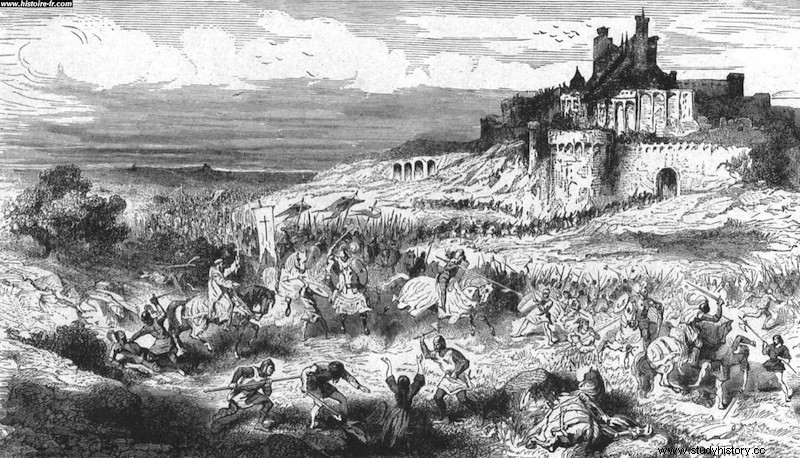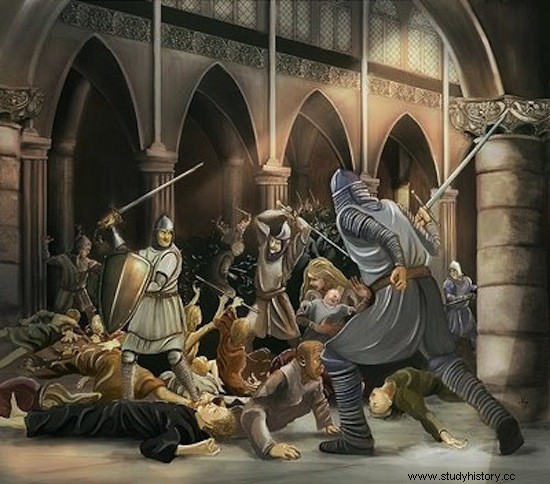Seeing that the shepherds of the Church had lost their way and, logically, their flocks had strayed from the path of the Lord, a philosophical-religious current spread throughout Lombardy, some areas of the Pyrenees and, above all, in the Languedoc, described by the Church as heretical, who advocated a return to the simplicity of the primitive Christian communities... they were the so-called Cathars (from the Greek «katharos » meaning pure), Albigensian (for the city of Albi) u good men . For them there were two basic principles:the Good (a spiritual world created by God) and Evil (the material world created by Satan). Only through austerity, piety and virtue could perfection and union with God be achieved. In addition, they were ahead of their time regarding the treatment of women, it was equal to equal, since if they had not reached perfection when they died their soul would migrate to another being:man, woman or animal. They rejected the sacraments - their only sacrament was the Consolamentum carried out through the imposition of hands and that would be equivalent to baptism and extreme unction-, the authority of the Pope and even the divinity of Christ... which has been a heresy for the Church. At first, the dispute was settled in public debates between the Dominican Domingo de Guzmán and the Cathars themselves, until…

Cathar or Occitania cross.
In 1208, Pope Innocent III He called for a crusade against the Cathar heretics with the promise of conquered castles and lands as booty. The King of France Philip II he supported the crusade from the beginning, since he hoped to seize the territories of the Crown of Aragon on French soil. They led the powerful Crusader army Simon de Montfort and the papal legate Arnau Amalric , and in defense of the Cathars the nobles of the territories and cities where this current had taken root, many of them vassals or allies of the Crown of Aragon. In July 1209, the city of Beziers It was where the miserable phrase was heard…
Kill them all, the Lord will know how to recognize his own.

The Crusader army besieged the city of Beziers and Arnau Amalric offered an ultimatum:if they handed over the Cathars they would not take the city -it is hard to believe a hyena when she has bloody fangs-. The city's inhabitants refused and the Crusaders stormed the city…burning, destroying, looting, and murdering all who stood in the way of the warriors of the Church. Faced with that indiscriminate massacre, Simón de Montfort asked the papal legate:
How do we distinguish heretics from the rest?
Kill them all, the Lord will know how to recognize his own; replied Arnau Amalric
The letter that Arnau Amalric sent to the Pope shows what happened there:
Today, His Holiness, twenty thousand citizens were put to the sword regardless of sex or age, and after the slaughter of the enemies, the entire city was looted and burned. Divine vengeance has done wonders.
And the chronicle of one of the crusaders who participated in the massacre:
I was ordered to go in and destroy the enemy. That was my job on that day and that was my mission. Not stopping to think if they were men, women or children. They were all the same, enemies.

After the Beziers massacre, the Pope warned Simón de Montfort so that an indiscriminate massacre would not be repeated. Carcassonne, Bram, Minerve, Termes, Lavaur, Les Cassés, Montferrand fell... but in these cities the strategy was changed. Now, when they take the cities, their inhabitants are no longer put to the knife, only bonfires are lit with a new highly flammable material... the Cathars . The Languedoc burns on all four sides and the pure They flee from city to city. King Peter II of Aragon he crossed the Pyrenees to try to free Tolosa from the siege, but in the battle of Muret (1213) he died. In 1215, Simon de Montfort controlled all of Occitania. With the death of Simón de Montfort (a stone fell on his head during a siege) and Innocent III, the Cathars have a respite and return little by little, as far as possible, to resume their lives. And since the joys do not last long in the house of the poor, the following Popes (Honorius III and Gregory IX) decided to resume the work undertaken by Innocent III, but this time, already with Gregory IX, with a different modality... the Inquisition . Not having the support of any noble and, therefore, of any city, the Cathars lived intermingled with the rest of the people, preaching and practicing in secrecy. So the grain had to be separated from the chaff and to make that sieve the Inquisition was sent to Tolosa in 1229.
And how to recognize the Cathars?
Although they had to change many of their habits from the golden days so as not to be easily recognized -such as going in pairs to help each other and not fall into temptation-, their physical appearance gave them away:if you took care of your personal hygiene (they washed every day with soap), you were excessively thin (they were vegetarians; they couldn't kill any animals because of what I mentioned before the migration of souls) and you were very pale-faced (they led an austere life, they hardly went out for work and the rest of the day They spent time in seclusion praying) you had many ballots to have to pass an interrogation by the Inquisition accused of heresy. The Crusaders did the general cleaning and the Inquisition did the selective cleaning.
And since we are dealing with the Inquisition, a manual published in 1578 made its intentions very clear…
Quoniam punitio no refertur primo y per se en correctionem y bonum eius qui punitur, sed en bonum publicum ut alij terreantur, y un avocentur malis committendis. (Because the punishment is not destined primarily or by itself to the correction of the one who is punished, but to the public good, so that everyone feels terror and stays away from committing those evils)
